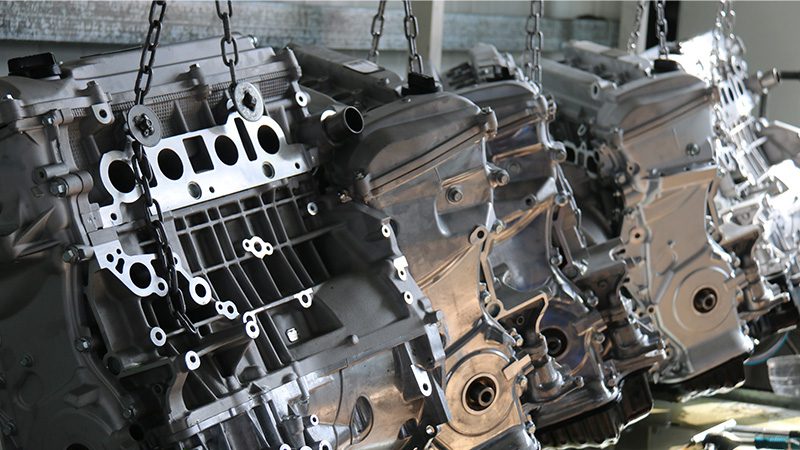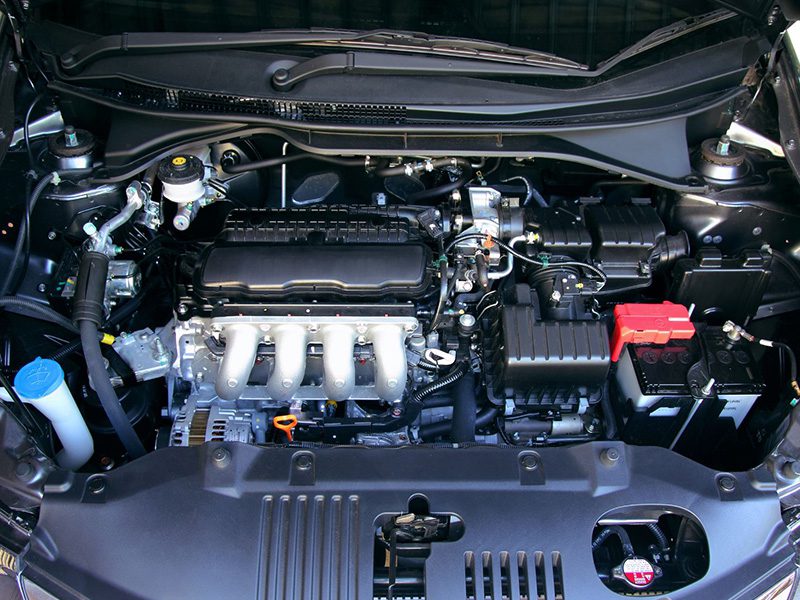Every drop of fuel and every second that a contemporary car runs matters. And it makes picking the proper engine more than just a technical choice. Today’s four-cylinder engines have more power and provide better gas mileage.
That’s why it’s an excellent choice for people who care about performance and those who want to save money. Understanding the main differences between 4-cylinder and 6-cylinder (V6) engines might help you make better decisions.
This article goes over the pros and cons of each format. You can find the correct mechanical muscle to fit your driving needs. Let’s examine more closely why 4-cylinder engines are so standard on modern highways.
What Does a 4-Cylinder Engine Do?
A 4-cylinder engine is an internal combustion engine. It has four cylinders powering cars within the larger engines. A reliable car cylinder is like an engine’s lung. Each cylinder consumes fuel and air to generate the power that moves your car.
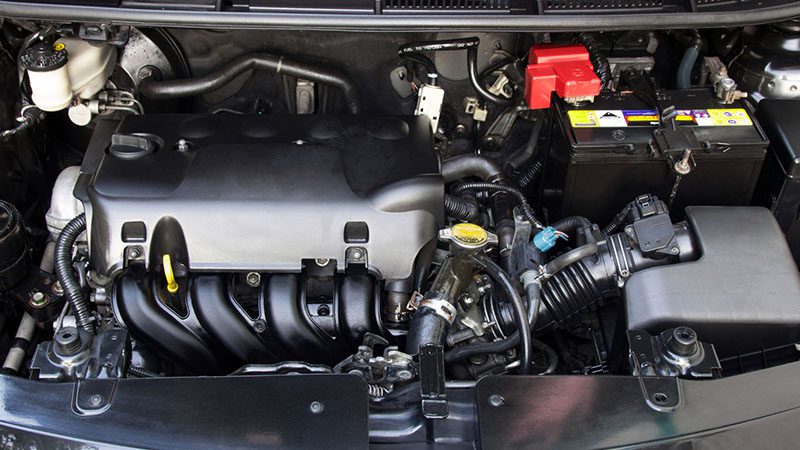
A cylinder is a space where a piston can move up and down. This movement changes chemical energy into mechanical energy. Four pistons work in four different cylinders of a 4-cylinder engine. They usually shoot in a specific order to make sure the power flows smoothly.
Four-Cylinder Combustion Cycle
A 4-cylinder engine uses an internal combustion process to turn fuel into mechanical energy. Each cylinder runs through it one at a time, but in a particular order.
- Intake Stroke: The piston goes down to pull in a mix of air and fuel (the fuel pump sends gas).
- Piston Stroke: The piston travels up during the compression stroke to compress the air-fuel mix.
- Power Stroke: The spark plug lights the compressed mixture. It generates an explosion that pushes the piston down.
- Exhaust Stroke: The piston goes back up to push out the gases that have already been used.
This cycle happens in a staggered rhythm for all four cylinders. There is always at least one cylinder head that can power the engine. It makes the output smooth, and the torque stays the same.
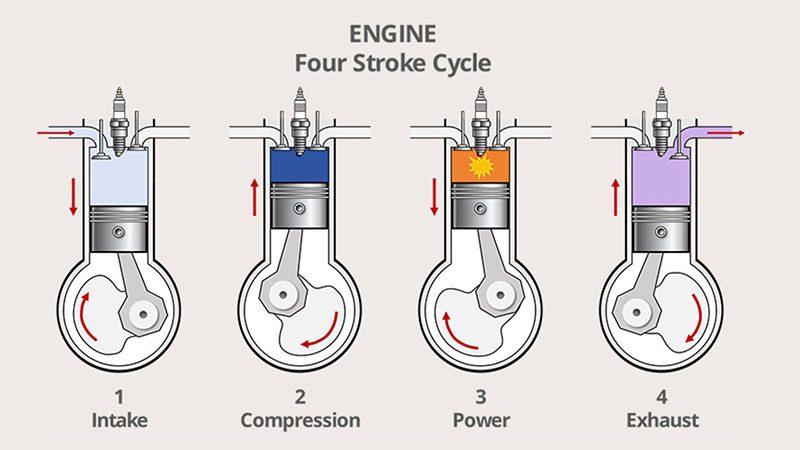
Types of Engine Configurations: Flat-4 vs Inline-4
1. I4 (Inline Fours)
This is how most 4-cylinder engines are set up. There is still a straight line of four cylinders. It looks like its small size might work well with front-wheel-drive autos. An easy-to-reach layout makes it simple to fix and maintain.
Pros:
- Less weight means better gas mileage.
- Needs fewer parts, is less complicated, and costs less.
- It can be found in cars like the Honda Civic and the Toyota Corolla.
2. Boxer Engine (Flat-4)
The cylinders are arranged in pairs that face outward and are horizontal. Subaru and Porsche are two companies that employ it a lot. Flat-4 lowers the centre of gravity, which makes handling and balance better.
Pros:
- Less vibration since the pistons move in opposite directions.
- Better stability when turning and driving fast.
- More polished the performance, like the Subaru WRX.
A 4-cylinder engine gets between 25 and 35 miles per gallon, depending on whether it has a turbocharger or a hybrid system. Today’s turbocharged four-cylinder engines may provide more than 250 horsepower, which is as much as previous V6 engines.
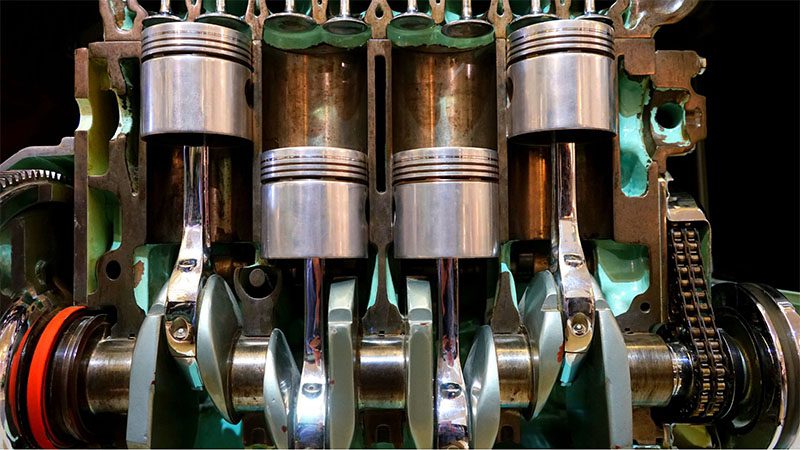
Piston Arrangement
For an Inline-4 (I4):
| Cylinder 1 | Cylinder 2 | Cylinder 3 | Cylinder 4 |
↑ ↑ ↑ ↑
Pistons lined together in a single row vertically.
For a Flat-4 (Boxer):
Cylinder 1 → ← Cylinder 2
Crankshaft
Cylinder 3 → ← Cylinder 4
The pistons move in opposite horizontal directions within the crankshaft. It makes the action more balanced, so there is less vibration.
Benefits of a Four-Cylinder Engine
1. How Well is the Fuel Efficiency
One of the main reasons why 4-cylinder engines are so popular nowadays is that they use less fuel. When combined with hybrid systems or turbochargers, many 4-cylinder cars get 25 to 40+ miles per gallon.
With a 1.6L I4 engine, the Hyundai Elantra Hybrid gets 54 MPG combined. Choose naturally aspirated engines for ease of use or turbocharged engines for a combination of power and efficiency.
2. Less Expensive to Own
Costs at first are usually lower than those of V6 models. There are fewer moving components; therefore, there is less possibility of mechanical failure. Changing the oil, belts, and spark plugs makes maintenance easier. And I4 layouts make things seem easier to reach.
3. Simple to Work On
Inline-4 engines are easy to fix and improve, which makes them great for anyone who likes to work on their cars. You may find a lot of aftermarket parts for intakes, exhausts, oecus, and turbo kits.
A growing and solid popularity needs lots of resources. Modding (personalized modification) is cheap and easy to do because of online forums, instructions, and component availability.
4. Applications that can be Used in Many Ways
4-cylinder engines are commonly found in sedans, hatchbacks, compact SUVs, hybrids, and even sports cars. Mazda, Honda, and Toyota are among the car companies that have made high-output I4s for both economy and performance trims.
5. Being Good for the Environment
Less CO2 is released since less fuel is burned. It helps meet the demanding Euro 6 and BS6 emission standards, especially in Europe and South Asia. They are utilized in cars that qualify for green tax breaks or subsidies.
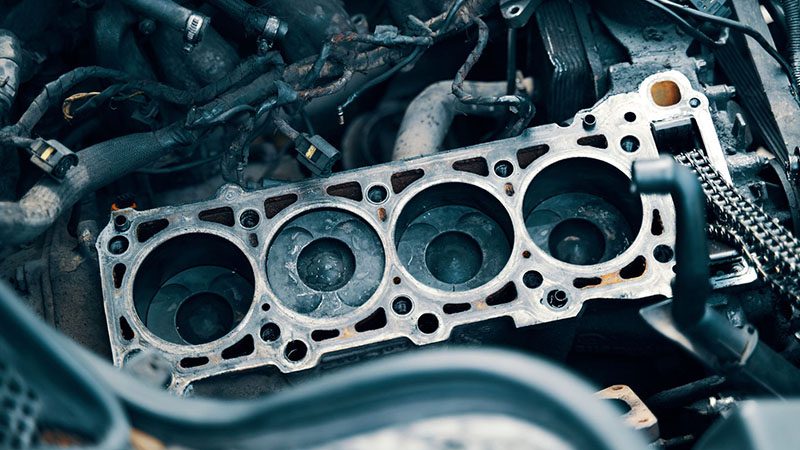
Uses for 4-Cyl Engines
Compact and mid-size sedans like the Toyota Corolla, Honda Civic, and Hyundai Elantra are examples of daily commuter vehicles.
- Eco-Friendly and Hybrid Cars: Hybrids have electric motors that help them produce fewer emissions. Common in cars like the Hyundai Ioniq and the Toyota Prius.
- Light SUVs and Crossovers: Even though they are smaller, many of them use 4-cylinder engines. Mazda CX-5, Honda CR-V, and Toyota RAV4 are all part of it.
- DIY Builds and Modding: People utilize them a lot to modify their cars with things like ECU tuning, cold air intakes, and turbo kits.
- Entry-Level Sports and Performance Cars: Brands like Subaru and BMW use turbocharged 4-cylinder engines in their performance cars. Think about the Subaru WRX Boxer engine and the BMW 2.0L TwinPower Turbo I4.
4-Cylinder Engines Have Some Drawbacks
1. Less Peak Performance (in stock form)
4-cylinder engines usually have less horsepower, torque, and towing capacity than V6 or V8 engines. Pick the turbocharged variants if you want quick acceleration or the ability to carry heavy loads.
2. More noise and vibration from the engine
When naturally aspirated, smaller engines might sound louder or feel rough when they are under load. Inline arrangement works well; however, it might not be as smooth as a V6 engine. To reduce vibrations, many modern I4 engines have active noise suppression, balance shafts, and engine mounts.
3. Not a lot of towing power
Not great for towing trailers, boats, or other heavy goods. Most SUVs with I4 engines can pull between 1,500 and 3,500 pounds, but V6 models can tow more than 5,000 pounds.
Why should You Compare Engines with Four and Six Cylinders?
People generally choose between a 4-cylinder and a V6 based on which features are most important to them. Buyers have to pick between fuel economy and price, and sheer performance and towing capacity.
People think that 4-cylinder engines are cheap and quick. Engines with six cylinders (V6), on the other hand, give vehicles and sports cars more power.
But improvements in turbocharging, hybridization, and engine design have made those lines less clear. It makes you think about making a new comparison, whether you’re buying, arranging an exchange, or optimizing a fleet.
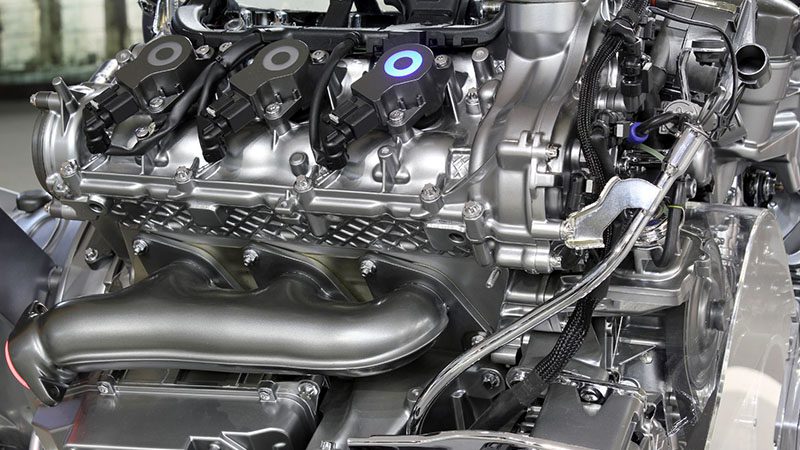
A Quick Look at 4-Cylinder and 6-Cylinder Engines
| Feature | Engine with Four Cylinders | 6-Cylinder Engine (V6) |
|---|---|---|
| Cylinder Heads (How Many Cylinders) | 4 | 6 |
| Setting up | Inline (I4) or Boxer (Flat-4) | V-shaped (V6); occasionally in a line |
| Weight of the Engine | Lighter (around 250 to 350 pounds) | Heavier, between 350 and 500 pounds |
| Power Output (How Much Power) | ~100–300+ horsepower (with a turbo) | ~250–400+ hp |
| Output of Emissions | Less CO2 footprint | More CO2 emissions |
| Torque | ~130–300 lb-ft | ~250 to 450 lb-ft |
| How well it uses gas | 25 to 40+ miles per gallon | 18–30 miles per gallon |
| How much can it tow | 1,500 to 3,500 pounds | 3,500 to 6,000 pounds |
| Long life | With proper care, they can go over 200,000 kilometres | Lasts a long time, but may need further work |
| Noise and Vibration | More obvious (particularly naturally aspirated) | Balanced firing makes everything run more smoothly |
| Cost (Initial + Upkeep) | Lower | More |
| Costs for repairs and replacements | Less (fewer cylinders) | More cylinders (higher) |
| Options for the aftermarket | Lots of turbo kits, ECU changes, and swaps for the intake and exhaust | Fewer cheap performance mods |
| Compatible with Different Types of Vehicles | Small SUVs, sedans, and compact cars | Big sedans, trucks, and performance SUVs |
| Perfect User Profiles | Drivers, commuters, and modders who care about the environment | People who want performance, people who pull trailers, and people who wish for luxury |
Key Things to Think About When Choosing a 4-Cylinder Engine
Driving Style and Performance Needs
Do you typically drive in the city or on the highway? Are you seeking a fun drive or just a smoother ride to work? Turbocharged I4 engines, like the Mazda SkyActiv and Ford EcoBoost, make 250 to 300+ horsepower. In terms of vehicle performing, further driving requires more refined the performance.
Naturally aspirated engines are easier to use and need less maintenance. Drivers in cities could want smaller engines that use less gas, while drivers on the highway might want turbocharged engines.
How fuel-efficient and bad for the environment it is
Compared to regular I4s, which get 25–35 MPG, hybrid 4-cylinder engines, like the Toyota Prius, get 50–60 MPG. The EPA says that turbocharged I4s are frequently 15–20% more efficient than equivalent V6s.
Use engines with hybrid systems or regenerative braking techniques to cut down on fuel costs and your carbon footprint.
Type of Engine Configuration
The Honda Civic and Toyota Corolla are easy to work on because they have a Compact Inline-4 (I4). The flat-4 with minimum vibration in the Subaru WRX and Porsche Cayman has the best handling.
The Mazda CX-5 Turbo and Hyundai Sonata Turbo both have strong power output and are fuel-efficient. The Hybrid I4 has the best MPG in its class, which means the Toyota Camry Hybrid and Hyundai Ioniq have lower emissions.
How to Keep It Running and Reliable
According to an AAA analysis, I4 engines cost 20% to 30% less to maintain than V6 engines. You could need specific service and premium gasoline for flat-4 and turbocharged engines.
And it adds to the costs of owning anything for a long time. Check out the history of the manufacturers. The I4 engine families from brands like Toyota, Honda, and Mazda are always quite reliable.
Cost Up Front vs. Value Over Time
Compared to greater engine trims, base-level I4 engines cost 10–20% less up front. You may save $3,000 to $5,000 over five years by using less fuel and doing less maintenance.
Figure out the tools you need to figure out the Total Cost of Ownership (TCO). Before you buy, it should allow you to evaluate the gasoline, insurance, depreciation, and maintenance costs of different engine types.
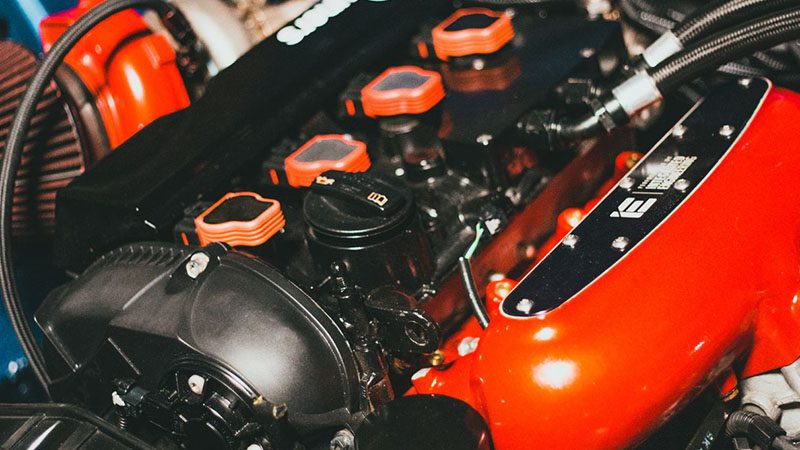
The Best 4-Cylinder Engines of 2025
A. Honda K20 and K24 Series
- Size: 2.0L to 2.4L
- Horsepower: 150–220
- Torque: around 140 to 180 lb-ft
Many Civic Si, Accord, and CR-V units have gone over 300,000 miles; thus, it has been proven to last. VTEC gives you high-rev performance and efficiency. There is a lot of aftermarket assistance for tuners and DIYers.
B. Dynamic Force 2.0L / Toyota 2ZR-FE
- Displacement: 1.8L to 2.0L
- Horsepower: 132 to 169
- Torque: around 128–151 lb-ft
It has a chain-driven timing mechanism that doesn’t need much maintenance. More fuel economy is better (up to 53 MPG in hybrid versions). It can be used in vehicles with a lot of volume, including the Corolla, Prius, and Camry.
C. Ford 2.3L EcoBoost
- Displacement: 2.3L
- Power: 285 to 350 hp
- Torque: 310 to 350 lb-ft
The Focus RS has a turbocharged punch that gives it up to 350 hp. You can find it in the Mustang EcoBoost, Explorer, and Lincoln MKC. The strong torque curve and tuning options are like extra features.
D. Volkswagen EA888 2.0T
- Size: 2.0L of space
- Available Power: 228 to 310 hp
- Torque: 258–280 lb-ft
Four fuel injectors work together to make turbocharging work smoothly. You may find it in the Golf GTI, Audi A4, and Tiguan. People know that the engine can be tuned and gets good gas mileage.
E. Boxer Engine for Subaru FB25
- Displacement: 2.5 litres
- Power: about 175 horsepower
- Torque: around 174 lb-ft
The flat-4 layout reduces the centre of gravity, which makes the car more stable. It is used in all-wheel-drive platforms like the Forester and Outback. The setup is recognized for being strong and able to handle rough terrain.

Frequently Asked Questions (FAQs)
1. What does it mean to have a “4-cylinder engine”?
It makes power by using four pistons that are contained in four combustion chambers (cylinders). Most designs stay in a straight line (inline-4) to save space and gas.
2. Is a V6 engine superior to a 4-cylinder engine?
It all depends on what you want. Engines with four cylinders are cheap, light, and use less gas. But a six-cylinder engine has more power and can tow more weight.
3. Is it possible to change a V6 engine for a 4-cylinder engine?
Yes, in a technical sense. But it’s a complicated process that includes making alterations to the drivetrain, engine mounting, gearbox compatibility, and ECU tuning. More often than not, people switch from a V6 engine to a more powerful 4-cylinder or turbo engine.
4. Do turbocharged four-cylinder engines build a car that works?
Yes. Reputable companies like Honda, Ford, Mazda, and VW make modern turbo I4 engines that can manage more pressure. To make things last longer, you need to do regular maintenance, notably oil changes.
5. How long do engines with four cylinders usually last?
With careful care, most 4-cylinder engines may last between 200,000 and 300,000 miles. Toyota, Honda, and Subaru are some of the brands that have a long history of making durable cars.
Finishing Up
The 4-cylinder engine is still the best choice for everything from simple commutes to high-speed thrill rides. The small size, greater fuel economy, and good horsepower make it virtually as versatile as anything else.
You might want to reach MPG goals, adjust torque curves, or just find a reliable way to go around. The 4-cylinder engine can still be a wise choice, though.
Partner with Woda Auto Technology to Push Your Engine Service Business
For 25 years, Woda Auto from Nanjing, China, has been a leader in the automobile components market. We have the best personnel with the most experience to support car system service businesses. Get in touch with us to take your engine service initiatives to the next level with our help.
